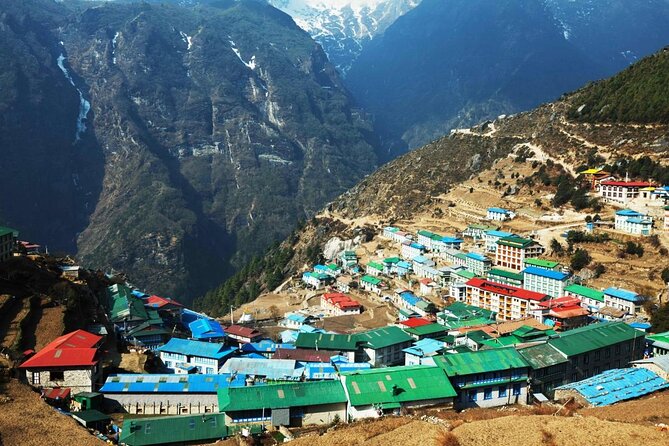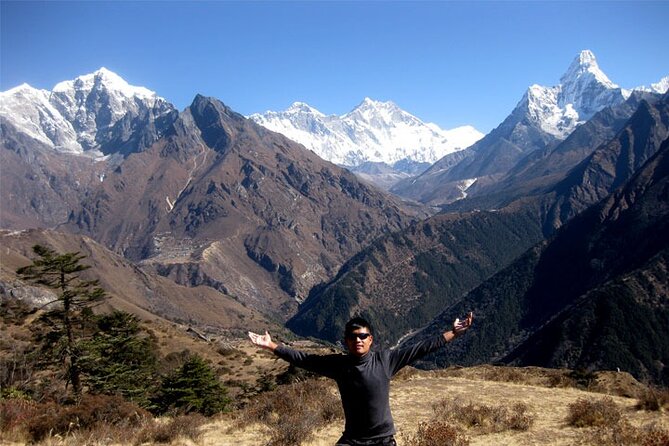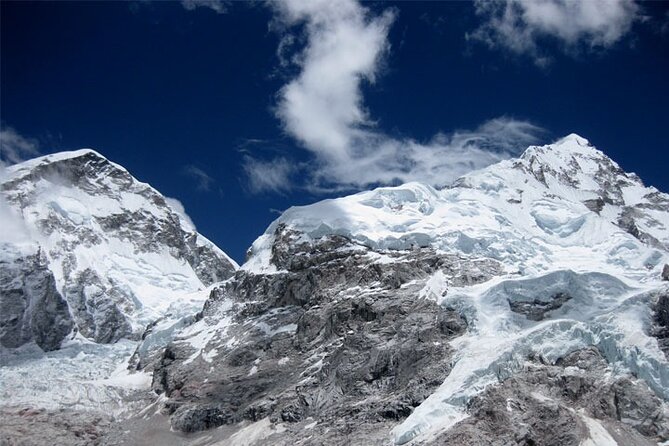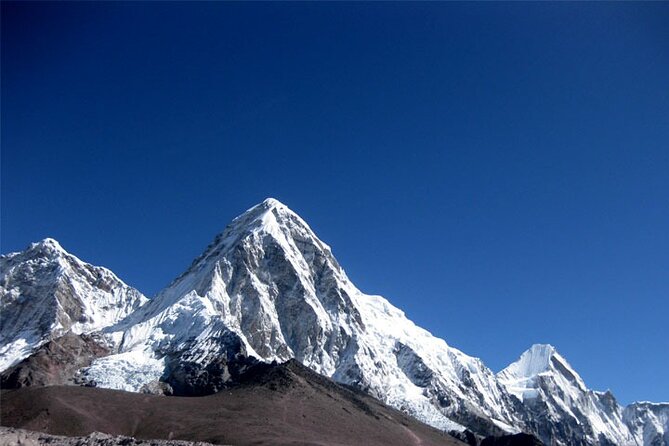Everest Base Camp Trekking – 13 Days
Set out on a journey to the iconic Everest Base Camp, where every step unveils breathtaking vistas and unparalleled adventure. The 13-day trekking experience offers a glimpse into the majestic Himalayas, but what truly awaits beyond the snow-capped peaks and winding trails?
Prepare to uncover the secrets of this legendary trek that beckons both novice and seasoned adventurers alike.
Key Points

- Proper gear selection is essential for comfort and safety during the 13-day Everest Base Camp trek.
- Obtain necessary permits like the Sagarmatha National Park Entry Permit for legal access and conservation support.
- Teahouses and lodges offer budget-friendly accommodations and traditional Nepalese meals along the trekking route.
- Prioritize health and safety by acclimatizing to altitude, staying hydrated, and being prepared for extreme weather conditions.
Itinerary Overview

Set out on a thrilling 13-day journey through the majestic Everest Base Camp trekking route, enjoying breathtaking landscapes and cultural experiences. The trail highlights include passing through vibrant Sherpa villages like Namche Bazaar, panoramic views from Kala Patthar, and the spiritual journey to Everest Base Camp itself.
To make this trek a success, proper equipment is essential. While some seasoned trekkers bring their gear, for those in need, equipment rental services are available in Kathmandu and Lukla. Renting gear like sleeping bags, trekking poles, and down jackets can lighten your load and ensure you have the necessary tools for this demanding adventure.
Proper equipment enhances comfort and safety, allowing you to focus on soaking in the wonders of the Himalayas.
Required Permits and Documentation

To embark on the Everest Base Camp trekking adventure, hikers must ensure they possess the necessary permits and documentation required for the journey. Permit requirements for the trek include obtaining the Sagarmatha National Park Entry Permit and the Khumbu Pasang Lhamu Rural Municipality Entrance Permit, which are essential for legal access to the region. These permits aim to regulate the number of trekkers and ensure conservation efforts in the area.
Plus, travelers should be aware of the visa regulations for Nepal. Most visitors can obtain a visa upon arrival at Tribhuvan International Airport in Kathmandu or at various land border crossings. It’s important to check the latest visa requirements and fees before embarking on the journey to avoid any complications during the trek.
Accommodation Options
With a variety of lodging choices ranging from cozy teahouses to comfortable lodges, trekkers on the Everest Base Camp adventure can find accommodation options to suit their preferences and budget along the trekking route.
-
Teahouses: These are basic, budget-friendly accommodations offering a cultural experience by staying with local families or in communal settings.
-
Lodges: More comfortable options with private rooms, attached bathrooms, and sometimes even hot showers, providing a balance between comfort and cost.
-
Booking: It’s advisable to book accommodations in advance, especially during peak trekking seasons, to ensure availability and secure preferred lodgings.
-
Reviews: Before booking, checking online reviews on platforms like TripAdvisor can help in selecting reputable accommodations based on previous trekkers’ experiences.
Meals and Food Preparation
Trekking to Everest Base Camp involves enjoying a variety of meals and experiencing food preparation in the mountainous region. Trekkers can participate in cooking classes to learn about local cuisine, including dishes like Dal Bhat, Sherpa stew, and Tibetan bread. Meals are typically hearty and warming to provide energy for the challenging trek.
Local teahouses and lodges along the route offer a chance to taste traditional Nepalese flavors. It’s common for meals to consist of rice, lentils, vegetables, and sometimes meat. Food preparation often involves simple techniques due to limited resources in the remote mountain areas.
Trekkers should embrace the opportunity to savor the unique tastes of the region while gaining insight into the culinary traditions of the Himalayas.
Altitude Sickness Awareness
Altitude sickness, also known as acute mountain sickness, can affect trekkers at high elevations due to the reduced oxygen levels in the air. To help prevent and manage altitude sickness, consider the following tips:
-
Altitude acclimatization: Ascend gradually to allow your body time to adjust to the decreasing oxygen levels.
-
Stay hydrated: Drink plenty of water to avoid dehydration, which can worsen altitude sickness symptoms.
-
Know the signs: Be aware of symptoms such as headaches, nausea, and dizziness, and inform your guide if you experience them.
-
Oxygen supplementation: In severe cases, oxygen supplementation may be necessary to alleviate symptoms and ensure safety.
Packing List Essentials

For those embarking on the Everest Base Camp trek, ensuring you have the right packing essentials is key to a successful and comfortable journey through the Himalayas. Here are some gear essentials and packing tips to consider:
| Gear Essentials | Packing Tips | Additional Recommendations |
|---|---|---|
| Moisture-wicking base layers | Pack light to ease trekking | Bring a refillable water bottle |
| Sturdy hiking boots | Use packing cubes for organization | Carry high-energy snacks |
| Down jacket | Pack layers for changing weather | Include a portable charger |
| Warm sleeping bag | Bring quick-dry towels | Don’t forget personal medications |
| UV protection sunglasses | Pack a first aid kit | Carry extra batteries for devices |
Ensuring you have these essentials will help you have a smoother and more enjoyable trek to Everest Base Camp.
Physical Fitness Preparation

To prepare effectively for the physical demands of the Everest Base Camp trek, individuals should focus on enhancing their overall fitness levels through targeted exercises and cardiovascular training. Here are some training tips and the health benefits associated with physical fitness preparation:
-
Training Tips:
- Incorporate uphill walking or hiking into your routine.
- Build strength through exercises like squats, lunges, and core workouts.
- Increase endurance with activities like running, cycling, or swimming.
- Practice carrying a backpack with gradually increasing weight to simulate trekking conditions.
-
Health Benefits:
- Improved cardiovascular health.
- Increased muscle strength and endurance.
- Better stamina and energy levels.
- Reduced risk of altitude-related illnesses during the trek.
Weather and Climate Considerations

Considering the Everest Base Camp trek’s diverse terrain and high altitudes, understanding the weather and climate conditions is crucial for a safe and enjoyable journey. The weather in the region can be unpredictable, ranging from sunny and clear skies to sudden snowstorms and high winds. Proper gear essentials such as insulated clothing, sturdy hiking boots, and a reliable backpack are vital. Acclimatization tips include staying hydrated, ascending slowly to allow the body to adjust to the altitude, and being aware of symptoms of altitude sickness. Below is a table summarizing the key gear essentials and acclimatization tips:
| Gear Essentials | Acclimatization Tips |
|---|---|
| Insulated Clothing | Stay Hydrated |
| Hiking Boots | Ascend Slowly |
| Backpack | Watch for Symptoms |
Communication and Connectivity
Navigating the remote trails of the Everest Base Camp trek requires a reliable means of communication and staying connected throughout the journey. When considering the communication and connectivity aspect of the trek, trekkers may face various challenges due to the rugged terrain and limited infrastructure.
To address these challenges, here are some key strategies and solutions:
-
Connectivity challenges: Expect limited or no mobile network coverage in many parts of the trek, especially at higher altitudes.
-
Communication strategies: Carry a satellite phone or a personal locator beacon for emergency communication.
-
Technology limitations: Due to power constraints, consider using portable solar chargers to keep devices powered.
-
Network solutions: Utilize teahouses with Wi-Fi facilities at certain stops along the route for intermittent connectivity.
Safety and Emergency Protocols
In remote and challenging environments like the Everest Base Camp trek, ensuring safety protocols are diligently followed is paramount for every trekker’s well-being. Risk assessment plays a crucial role in preparing for any emergency that may arise during the trek. It is essential to be aware of the emergency procedures in place to handle situations swiftly and effectively. Below is a table outlining key safety and emergency protocols to keep in mind:
| Safety and Emergency Protocols | Description | Contact |
|---|---|---|
| Altitude Sickness | Recognize symptoms early | Trekking guide |
| Weather Conditions | Stay informed | Local authorities |
| Emergency Evacuation | Helicopter rescue available | Trekking agency |
| First Aid Kit | Carry essential supplies | Trekking guide/Teammates |
| Communication Devices | Keep in touch | Satellite phone/Local SIM |
Cultural Etiquette and Respect
When embarking on the Everest Base Camp trek, trekkers must respect and adhere to the cultural etiquette of the local communities they encounter along the journey. Understanding and following cultural customs and local traditions not only shows respect but also enriches the overall trekking experience.
To ensure a harmonious interaction with the locals, trekkers should:
- Greet Locals Appropriately: Learn basic greetings like ‘Namaste’ and use them when meeting locals.
- Dress Modestly: Respect local norms by dressing modestly, especially when visiting religious sites.
- Ask Permission Before Taking Photos: Always seek permission before taking photos of locals or cultural sites.
- Respect Religious Sites: Maintain silence and follow any specific rules when visiting temples or monasteries.
Environmental Sustainability Practices
Trekking enthusiasts can actively contribute to environmental sustainability during their Everest Base Camp journey by implementing eco-friendly practices. Sustainable practices such as carrying reusable water bottles to reduce plastic waste, disposing of litter properly, and using biodegradable toiletries can help preserve the natural beauty of the region.
Conservation efforts like staying on designated trails, respecting wildlife habitats, and supporting local eco-friendly lodges also play a crucial role in protecting the fragile ecosystem of the Himalayas. By being mindful of their environmental impact and making conscious choices along the trek, travelers can minimize their carbon footprint and ensure that future generations can continue to enjoy the stunning landscapes of the Everest region.
Trekking Tips for Success
For a successful trek to Everest Base Camp, prioritizing adequate acclimatization is crucial to ensure a safe and enjoyable journey through the high altitudes of the Himalayas. To enhance the chances of a successful trekking experience, consider the following tips:
-
Gear Selection: Invest in high-quality, lightweight gear suitable for the harsh mountain conditions. Items like sturdy trekking boots, warm layers, a reliable backpack, and a good sleeping bag are essential.
-
Route Planning: Familiarize yourself with the trekking route, including key stops, altitude changes, and potential challenges. Understanding the terrain can help you prepare mentally and physically for the journey.
-
Hydration: Stay well-hydrated throughout the trek to combat altitude sickness and maintain energy levels.
-
Listen to Your Body: Pay attention to any signs of altitude sickness and communicate openly with your guide to ensure a safe trek.
Common questions
Can I Bring My Own Trekking Gear or Is It Provided by the Tour Company?
When trekking, you can bring their personal gear or opt for rental options. The tour company usually provides essential equipment but may not cover personal gear. It’s advisable to clarify specifics with the company before embarking on the journey.
Are There Any Traditional Ceremonies or Rituals That Take Place During the Trek?
During the trek, travelers may experience cultural celebrations and ceremonial rituals that reflect local customs and religious practices. These traditions offer a unique insight into the spiritual essence of the region, enhancing the trekking experience.
How Are Waste and Trash Managed Along the Trekking Route?
Waste management along trekking routes involves strategic planning. Recycling initiatives aim to minimize environmental impact. Local guides and porters prioritize keeping trails clean. Visitors are encouraged to carry out their trash, fostering a sustainable and eco-friendly trekking experience.
Are There Opportunities to Interact With Local Communities or Learn About Their Traditions?
Local interactions and culture opportunities enrich the journey. Travelers can engage with communities, participate in traditions, and gain insights into local ways of life. These interactions foster a deeper connection to the region and its people.
Is There a Recommended Gratuity Amount for Guides and Porters at the End of the Trek?
When considering cultural etiquette and tipping practices, it is customary to show social responsibility by offering gratuities to guides and porters at the end of the trek. This act aligns with local customs and acknowledges their hard work.
Last Words
Embark on the Everest Base Camp trekking adventure for an unforgettable 13-day journey filled with breathtaking landscapes and unforgettable memories.
With top-tier ratings, convenient logistics, and a focus on safety and sustainability, this trek promises a seamless and secure experience for all participants.
Don’t miss out on the opportunity to explore the majestic Himalayas and reach the iconic Everest Base Camp with this epic adventure.